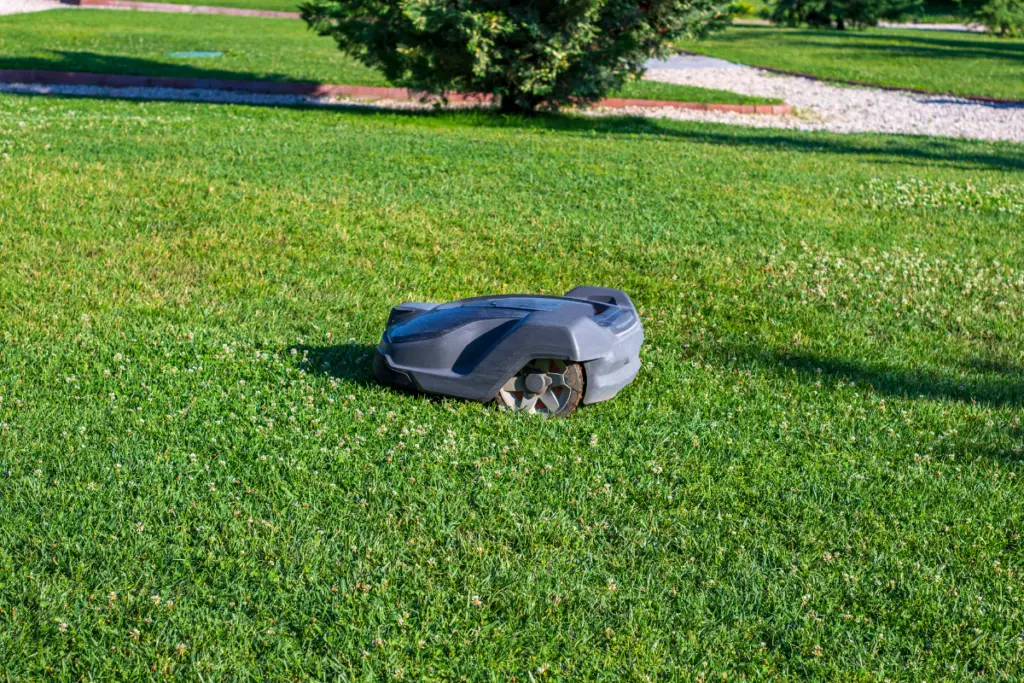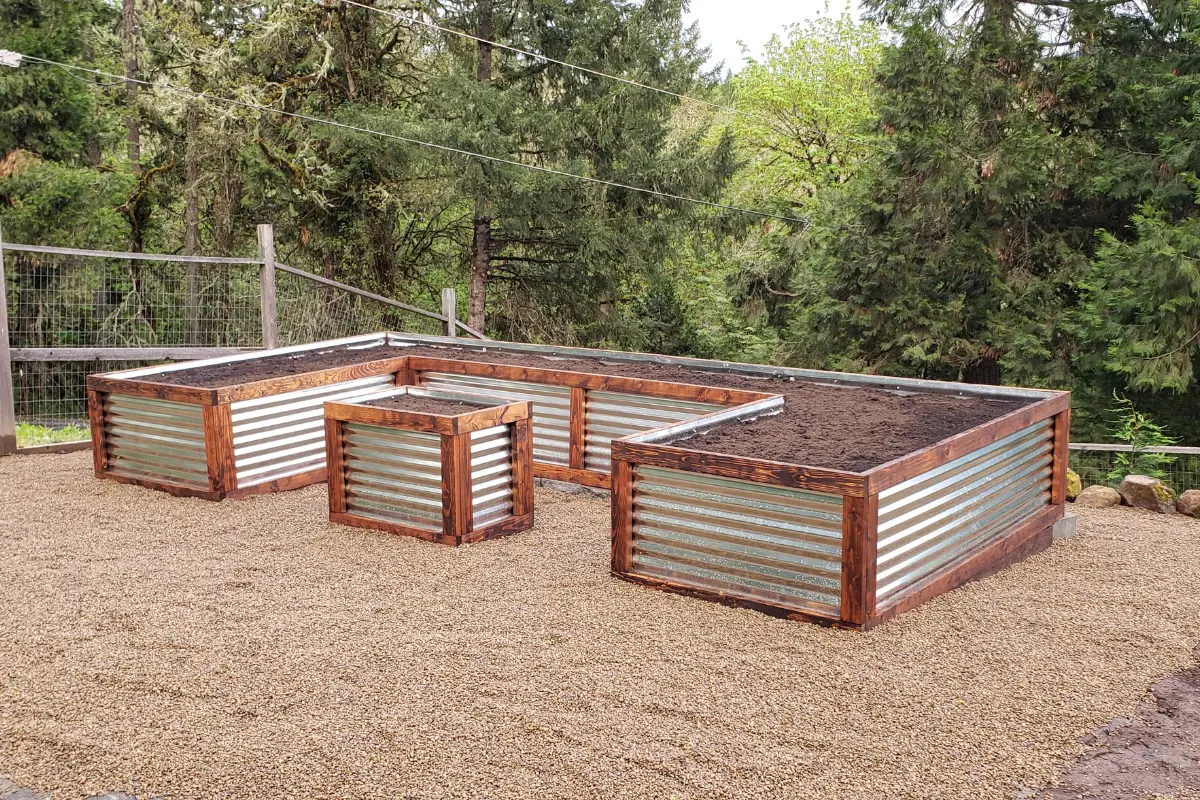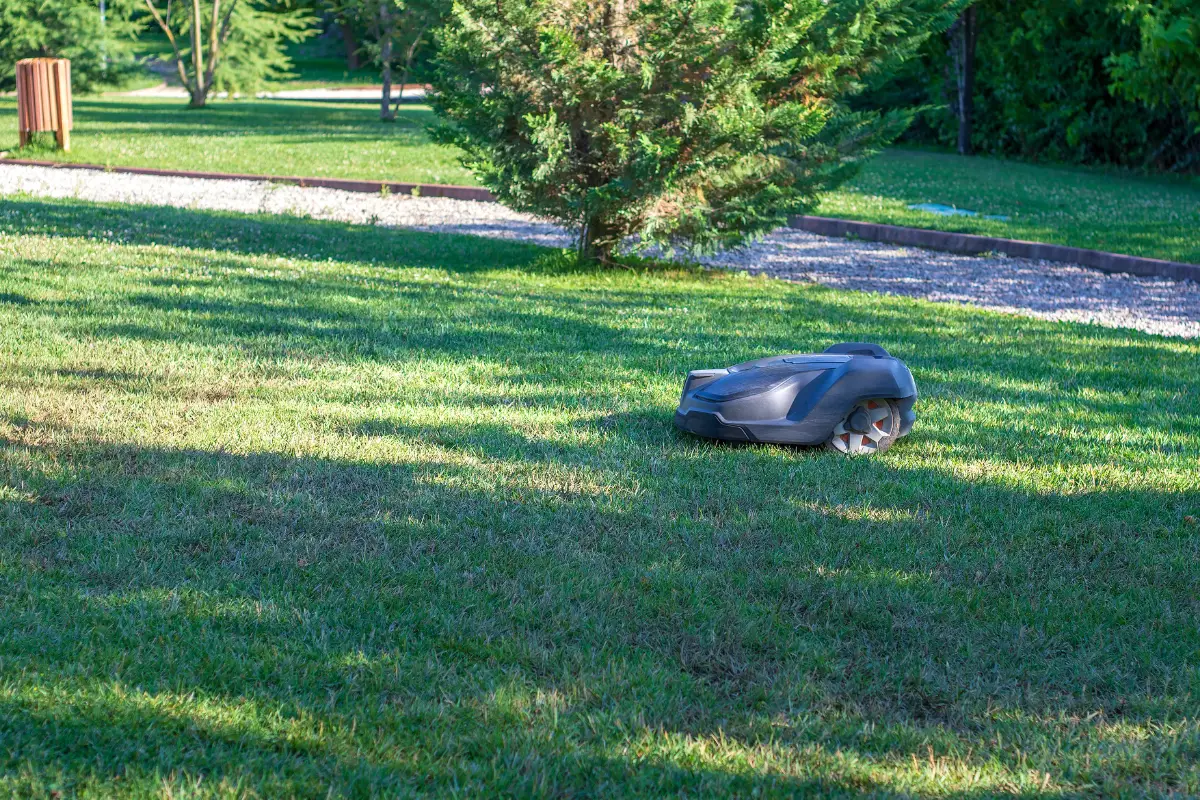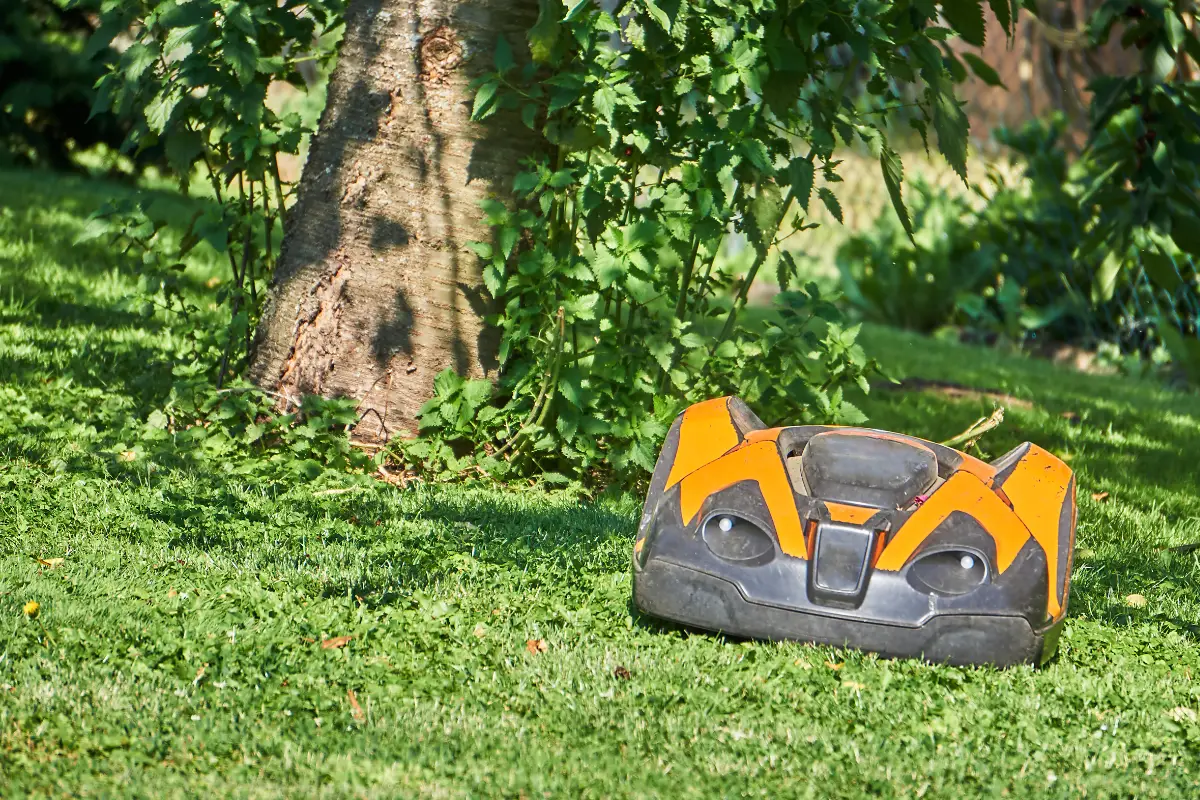Robotic lawn mowers are becoming increasingly popular due to their convenience and ease of use.
However, many homeowners may wonder if they need a special type of lawn to use a robotic lawnmower.
The answer is no, but there are some factors to consider when setting up your lawn for a robotic mower.
One important factor to consider is the size of your lawn. Robotic mowers are best suited for smaller lawns, typically less than one acre.
If you have a larger lawn, you may need to purchase multiple robotic mowers or consider a traditional lawn mower.
Additionally, robotic mowers work best on level terrain, so if your lawn has steep hills or uneven terrain, you may need to make some adjustments to ensure the mower operates properly.

Table of Contents
Understanding Robotic Lawnmowers
Robotic lawnmowers are fully autonomous lawn mowers that use sensors and navigational technology to cut grass.
They are designed to be a convenient and time-saving alternative to traditional gas or electric mowers.
Here are some key things to understand about robotic lawnmowers:
How Robotic Lawnmowers Work
Most robotic lawnmowers use a boundary wire to notify it of where it can and cannot mow.
The concept is very similar to an electric dog fence – a sensor can tell when it is near the wire by the frequency the wire emits.
The boundary wire can be laid above ground with stakes or staples or buried in the ground 1-4 inches.
The mowers hustle around your lawn, quietly mowing on a predetermined schedule within a predetermined area of lawn.
The area mowed is regulated by guide wires — much like an invisible fence for dogs.
Using the app on your phone or the manual power button, you prompt your automatic lawn mower to move around your lawn, cutting the grass and using its sensors (guided by the charged perimeter wire) to remain on the mapped path and avoid obstacles.
Many robot lawn mowers use a floating deck design that allows the user to adjust the cutting height.
Benefits of Robotic Lawnmowers
Robotic lawnmowers offer several benefits over traditional mowers. They are fully autonomous, have zero emissions, and are easy to use.
They are also much quieter than traditional mowers, making them ideal for use in residential areas.
Robotic mowers are excellent options if you find mowing a chore, have mobility issues, or are away from home for extended periods.
Limitations of Robotic Lawnmowers
While robotic lawnmowers offer many benefits, they do have some limitations.
They are typically more expensive than traditional mowers, and they require a certain level of maintenance and upkeep.
Additionally, they may not be suitable for use on very steep or uneven terrain, and they may struggle to mow areas with a lot of obstacles, such as trees or flower beds.
- Highly intelligent robotic lawn mower: GARDENA SILENO Minimo automatically mows yards up to 2700 sq ft using PATENTED streak-free technology, with easy connectivity via Bluetooth EasyApp Control, Auto-Schedule and EasyConfig
- Precise, silent navigation: Relax in your backyard while SILENO Minimo expertly navigates narrow spaces and tight corners while quietly cutting your grass with one of the quietest in class noise levels of 57 dbA
- Safe and reliable: The boundary wire ensures the Robotic Lawn Mower only mows the areas specified while collision sensors ensures the mower operates safely with no accidents or damage to your garden
- All-weather and terrain: SILENO keeps mowing rain or shine and cuts all shapes of lawns within the boundary wire limits, from simple to complex including slopes of up to a 35 percent gradient (19°)
- DIY Installation: Easily set-up your robotic mower at home, using our installation videos or user-friendly instructions and everything you need, provided in the b
Prices pulled from the Amazon Product Advertising API on:
Product prices and availability are accurate as of the date/time indicated and are subject to change. Any price and availability information displayed on [relevant Amazon Site(s), as applicable] at the time of purchase will apply to the purchase of this product.
Assessing Lawn Requirements
When considering a robotic lawnmower, it is important to assess the lawn requirements to determine if a special lawn is needed.
Here are some factors to consider:
Lawn Size and Shape
Robotic lawnmowers are designed to work on lawns of various sizes and shapes. However, some models may have limitations on the maximum lawn size they can handle.
It is recommended to choose a model that can handle the size and shape of your lawn.
Slopes and Obstacles
Robotic lawnmowers are capable of handling slopes and obstacles, but the degree of slope and the size of obstacles can affect their performance.
It is important to choose a model that can handle the slope and obstacles in your lawn.
Grass Type
Different grass types have different growth patterns and require different cutting heights.
Some robotic lawnmowers are designed to work with specific grass types, while others can handle multiple types.
It is important to choose a model that is compatible with the grass type in your lawn.
Maintenance
Robotic lawnmowers require regular maintenance, such as cleaning the blades and sensors, and replacing the blades when necessary.
It is important to choose a model that is easy to maintain and has readily available replacement parts.
Choosing the Right Lawn for Robotic Lawnmowers
When considering purchasing a robotic lawnmower, it is important to make sure that your lawn is suitable for this type of mower.
Here are a few factors to keep in mind when choosing the right lawn for a robotic lawnmower.
Lawn Size and Shape
Robotic lawnmowers are best suited for smaller lawns that are relatively flat and have a simple shape.
They may struggle with larger, more complex lawns, especially if there are narrow passages or tight corners.
It is important to check the manufacturer’s recommendations for lawn size before making a purchase.
Grass Type
Robotic lawnmowers are compatible with most grass types, including Bermuda, fescue, and bluegrass.
However, it is important to make sure that your grass is healthy and well-maintained before using a robotic lawnmower.
If your grass is too long or too thick, the mower may struggle to cut it effectively.
Terrain and Slope
Robotic lawnmowers are designed to handle gentle slopes, but they may struggle with steeper inclines.
It is important to check the manufacturer’s recommendations for maximum slope before making a purchase.
If your lawn has a steep slope, it may be better to use a traditional lawnmower or hire a professional landscaper.
In addition to these factors, it is important to make sure that your lawn is free of debris and obstacles before using a robotic lawnmower.
This will help prevent damage to the mower and ensure that it operates effectively. With the right lawn and proper maintenance, a robotic lawnmower can be a convenient and efficient way to maintain your lawn.
Special Lawn Features for Robotic Lawnmowers
When it comes to robotic lawnmowers, not all lawns are created equal. Some lawns may require special features to ensure that the mower operates efficiently and effectively.
Here are some important lawn features to consider when using a robotic lawnmower.
Boundary Wire
One of the most important features of a robotic lawnmower is its boundary wire. This wire is used to define the perimeter of the lawn and keep the mower within that boundary.
The wire is typically installed around the edge of the lawn and can be buried underground or simply laid on the surface of the ground.
It is important to ensure that the boundary wire is installed correctly and securely. If the wire is not installed properly, the mower may go outside of the designated area, causing damage to the lawn or the mower itself.
Additionally, if the wire is not buried deep enough, it may be damaged by other lawn equipment or become a tripping hazard.
Charging Station Placement
Another important feature to consider is the placement of the charging station. The charging station is where the mower goes to recharge its battery when it runs low.
It is important to place the charging station in a location that is easily accessible to the mower, but also out of the way of foot traffic and other lawn equipment.
Ideally, the charging station should be placed in a flat, open area that is free from obstacles.
Additionally, the charging station should be located near a power source to ensure that the mower can be charged quickly and efficiently.
Obstacle Detection
Finally, obstacle detection is an important feature to consider when using a robotic lawnmower.
Obstacle detection sensors are used to detect objects in the mower’s path and prevent it from colliding with them.
It is important to ensure that the obstacle detection sensors are functioning properly and are not obstructed by debris or other objects.
If the sensors are not working correctly, the mower may collide with objects in its path, causing damage to the mower or the object in question.
Maintaining Your Lawn for Robotic Lawnmowers
Regular Lawn Care
To ensure that your robotic lawnmower is able to function properly, it is important to maintain your lawn regularly.
This includes tasks such as mowing, watering, and fertilizing. By keeping your lawn healthy and well-maintained, you can help your robotic lawnmower work more efficiently and effectively.
Mowing your lawn regularly is key to maintaining a healthy lawn for your robotic lawnmower.
Robotic lawnmowers are designed to cut grass frequently and at a low height, which can help promote healthy growth.
However, if your grass is too long, your robotic lawnmower may struggle to cut it effectively.
It is recommended to mow your lawn at least once a week during the growing season to keep it at the optimal height for your robotic lawnmower.
Watering your lawn is also important for maintaining healthy grass. A well-watered lawn can help prevent dry spots and promote healthy growth.
However, it is important not to overwater your lawn, as this can lead to waterlogged soil and other problems.
It is recommended to water your lawn deeply once or twice a week, depending on the weather and soil conditions.
Fertilizing your lawn can also help promote healthy growth and keep your robotic lawnmower functioning properly.
However, it is important to use the right type and amount of fertilizer, as too much can harm your lawn and your robotic lawnmower.
It is recommended to fertilize your lawn once or twice a year, depending on the type of grass and soil conditions.
Managing Lawn Growth
In addition to regular lawn care, it is important to manage the growth of your lawn to ensure that your robotic lawnmower is able to function properly.
This includes tasks such as trimming edges, removing debris, and managing weeds.
Trimming the edges of your lawn can help prevent your robotic lawnmower from getting stuck or damaged by obstacles such as rocks or tree roots.
It is recommended to trim the edges of your lawn regularly, especially around trees, flower beds, and other landscaping features.
Removing debris such as sticks, rocks, and other objects from your lawn can also help prevent damage to your robotic lawnmower.
It is recommended to remove debris from your lawn regularly, especially before mowing.
Managing weeds is also important for maintaining a healthy lawn for your robotic lawnmower. Weeds can compete with grass for nutrients and water, and can also interfere with the operation of your robotic lawnmower.
It is recommended to remove weeds from your lawn regularly, either by hand or with a weed killer product.
By following these tips for maintaining your lawn for robotic lawnmowers, you can help ensure that your robotic lawnmower is able to function properly and keep your lawn looking great all season long.
Conclusion
In conclusion, a special lawn is not required for a robotic lawnmower, but some preparation is necessary.
It is important to ensure that the lawn is free of debris, and any obstacles are removed before installation.
The mower should also have a clear path to follow, which can be achieved by installing boundary wires around the perimeter of the lawn.
Robotic lawnmowers can be an excellent investment for those who want to save time and effort in maintaining their lawn.
They are easy to use, require minimal maintenance, and can cut the grass to a consistent length.
Robotic mowers are also environmentally friendly, as they produce zero emissions and use less energy than traditional mowers.
However, it is important to note that robotic lawnmowers can be costly, and their effectiveness may depend on the size and shape of the lawn.
Before purchasing a robotic lawnmower, it is important to consider the size and layout of the lawn, as well as any potential obstacles or challenges that may affect its performance.
- How to Dry Basil Leaves: A Professional Guide
- Is an Avocado a Fruit or Vegetable? Simple Answer and Explanation
- Does Pineapple Have Seeds? Exploring the Anatomy of Pineapples
- Blooming Through Winter: Can I Grow Vegetables Indoors in the Winter?
- What Can You Grow in a Greenhouse All Year Round: A Guide to Year-Round Greenhouse Gardening
- Are Blueberries Blue? Debunking the Myth of Their Color

















